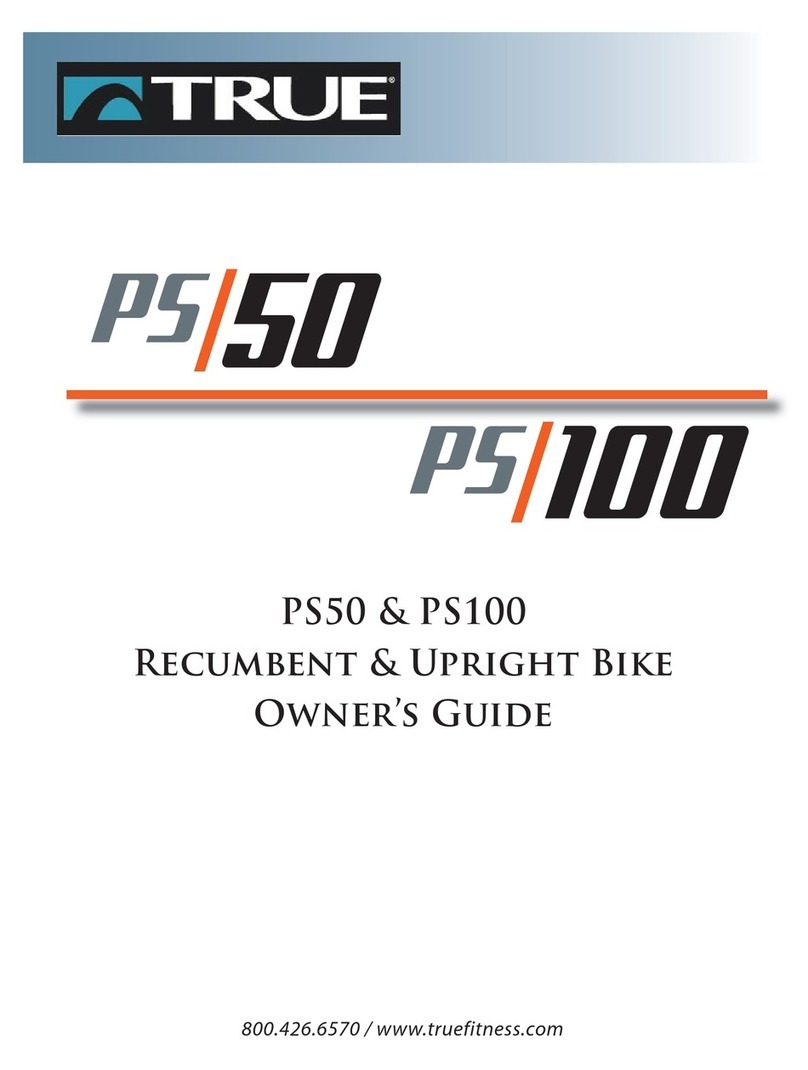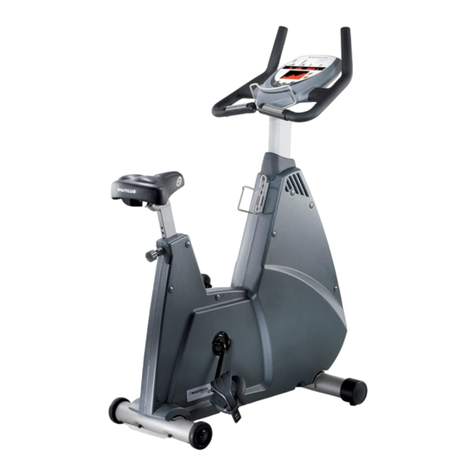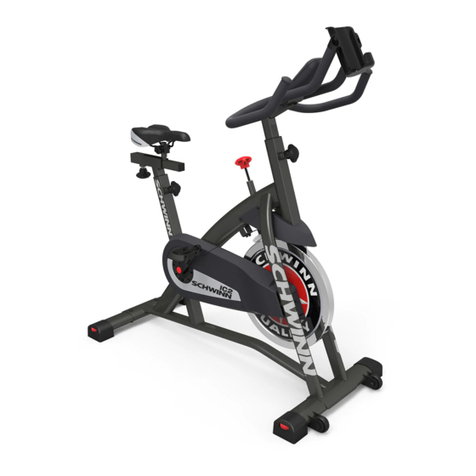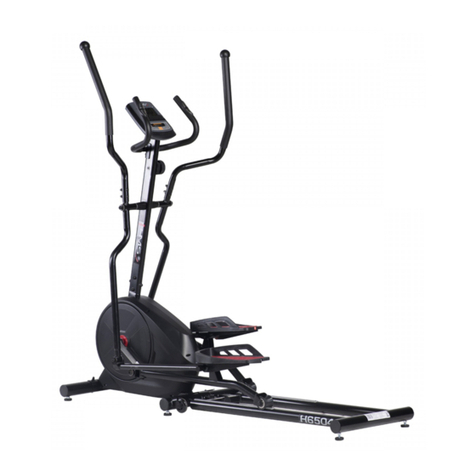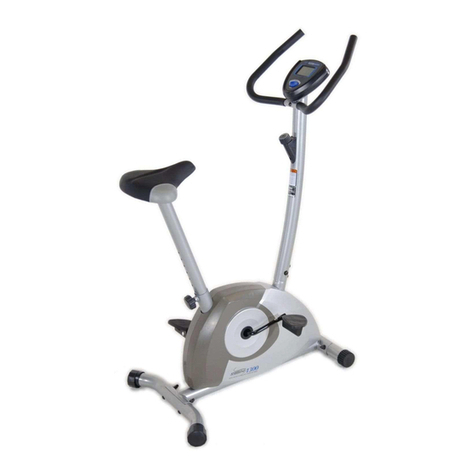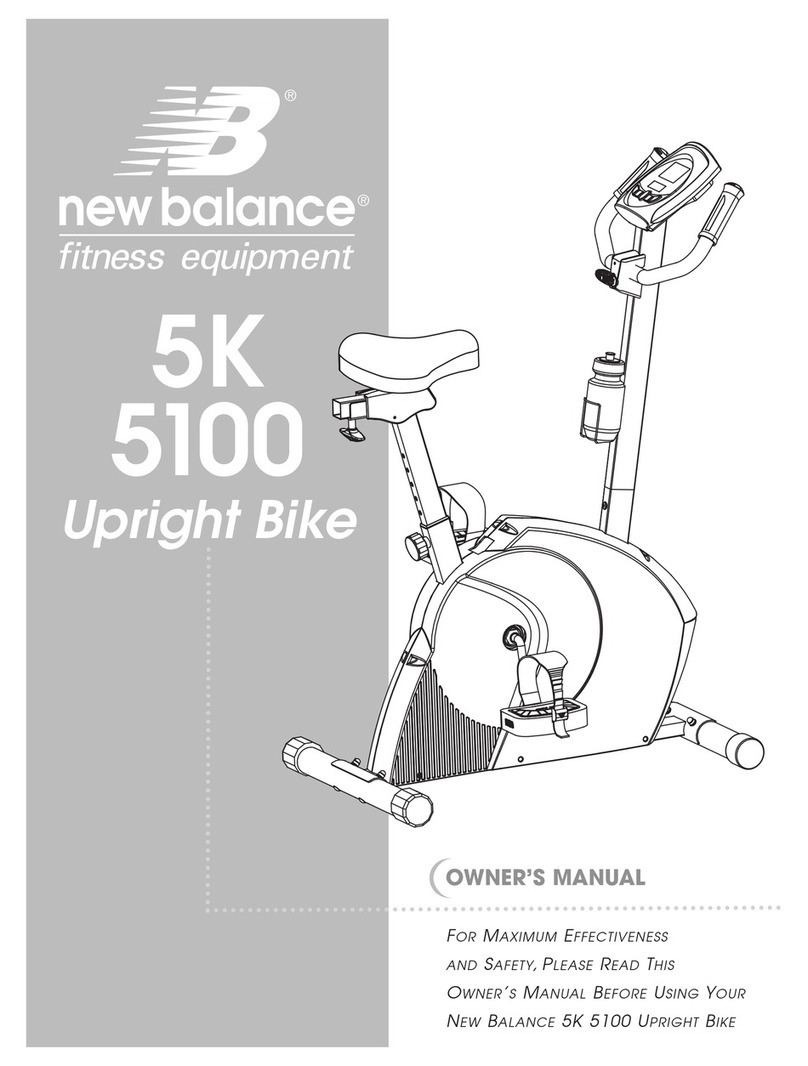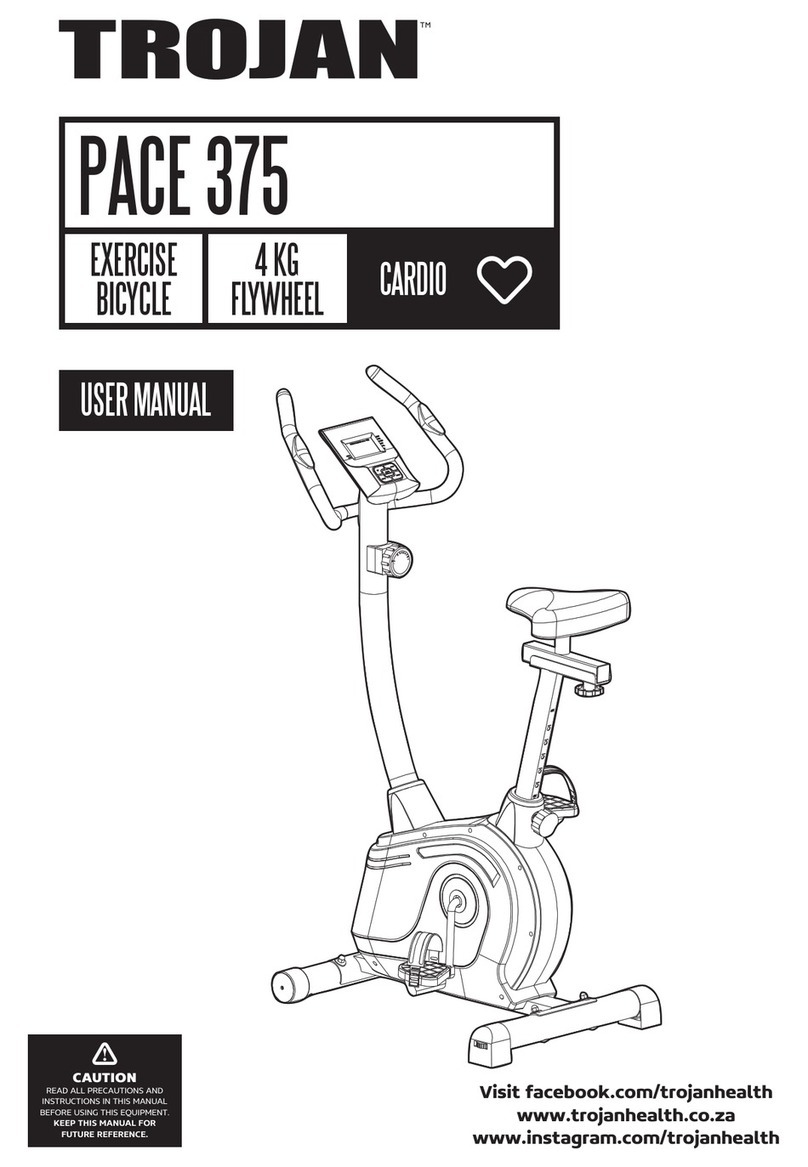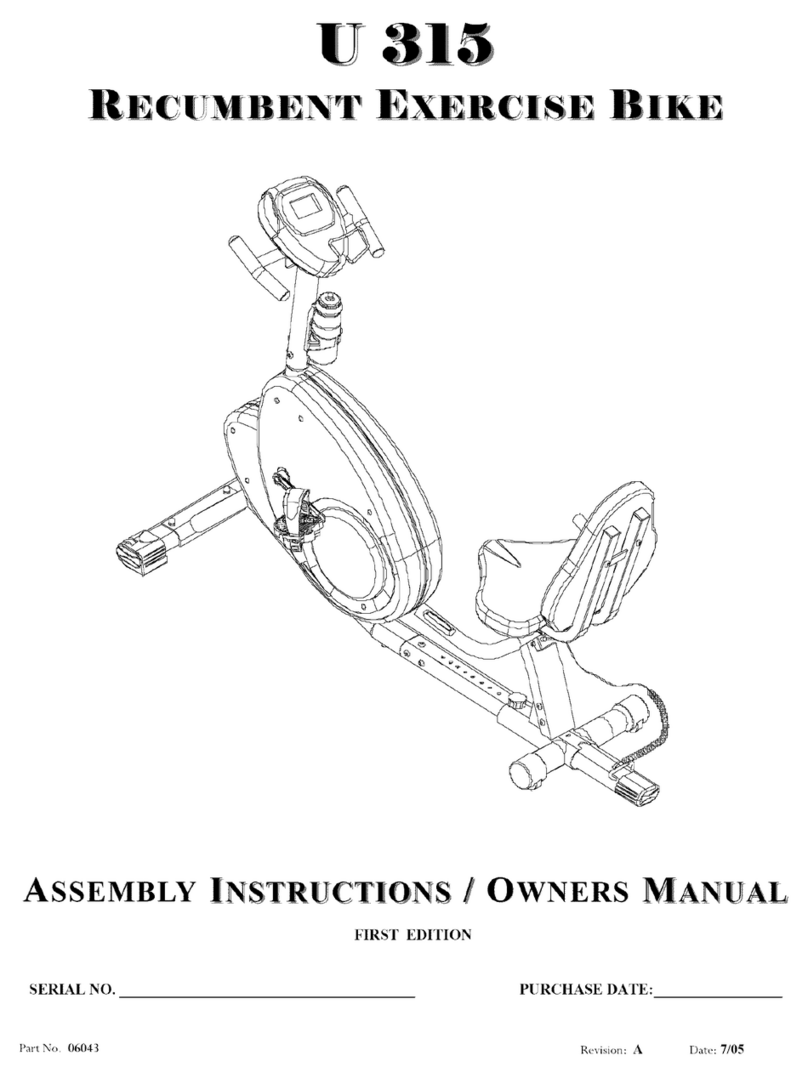True Fitness CS8.0 User manual

truefitness.com / 800.426.6570 / 1.636.272.7100
CS8.0 Upright and
Recumbent Bike
Owner’s Guide

In 1981, Frank Trulaske launched
TRUE Fitness®, and began
manufacturing premium
hand-crafted treadmills.
His team’s obsession with
quality has propelled
TRUE to the top of
the fitness industry
and has created one of
America’s oldest, largest
and most respected
fitness equipment
manufacturers.
Over the years, TRUE
has designed, developed,
patented and fabricated
many new cutting-edge
innovations for their products. Such
advancements include ground-
breaking new features, state-of-the-
art manufacturing components, and
technological breakthroughs.
While TRUE has expanded
its line of products,
intensive quality control
standards guarantee
excellence in every
phase of production.
This results in the finest
products available in the
marketplace.
TRUE is the choice for
cardio workouts among
beginners, rehab patients
and top athletes world-
wide.
Today TRUE Fitness
offers a full line of
premium elliptical
trainers, treadmills, upright and
recumbent bikes, and flexibility
equipment.
Thank You For Selecting True
“Our original
goal was to build
the world’s best
fitness equipment,
and today we
believe we’re
doing it!”
-Frank Trulaske

CS8.0 Bikes Owner’s Guide 3
Review for Your Safety
I S I
When using this exercise machine, basic precautions should
always be followed, which includes the following:
Read and understand all instructions and warnings prior to use.
Obtain a medical exam before beginning any exercise program.
If at any time during exercise you feel faint, dizzy, or experience
pain, stop and consult your physician.
Obtain proper instruction prior to use.
Inspect the bike for incorrect, worn, or loose components and do
not use until corrected, replaced, or tightened prior to use.
Do not wear loose or dangling clothing while using the bike.
Care should be used when mounting or dismounting the bike.
Read, understand, and test the emergency stop procedures before
use.
Disconnect all power before servicing the bike.
Do not exceed maximum user weight of 300 lbs.
Keep children and animals away.
All exercise equipment is potentially hazardous. If attention is not
paid to the conditions of equipment usage, death or serious injury
could occur.

CS8.0 Bikes Owner’s Guide 4
Starting Up
During
Your
Workout
Pausing
Your
Workout
Begin pedaling. The display will start up in WORKOUT SETUP.
QUICK START into a manual workout by pressing .
SELECT A DIFFERENT WORKOUT by pressing the workout
keys. Press workout keys more than once for more workouts.
ACCEPT EACH SETTING AND MOVE TO THE NEXT ONE
by pressing . Enter your personal data — weight, age, and
sex — for best results.
BEGIN YOUR WORKOUT by pressing at any time.
ADJUST YOUR EXERCISE WORKLOAD by using the or
keys or the numeric keys.
VIEW DIFFERENT DISPLAY DATA by pressing the Change
Display key to alternate between two different sets of data.
CHANGE WORKOUTS on-the-fly by pressing other workout
keys.
The bike will retain your workout data for about 15 seconds after
you stop pedaling.
Quick Start
Specifications/Features/Software are subject to change

CS8.0 Bikes Owner’s Guide 5
Table of Contents
Quick Start ..............................................................................................4
1. Introduction........................................................................................6
2. Riding Your Bike........ ......................................................................10
Basic operation (except console)
3. The Display.........................................................................................17
Describes each key and data display feature
4. Workout Setup..................................................................................23
5. Manual Control.................................................................................25
6. Pre-Set Workouts..............................................................................27
Details on basic exercise modes
7. Heart Rate Control...........................................................................33
Foolproof heart rate feedback workouts
8. Calorie Goal Workout.....................................................................42
9. Designing Your Own Workout......................................................45
10. Fitness Test......................................................................................50
11. Medical and Ergometer Mode.....................................................56
12. Other Functions.............................................................................59
13. Creating an Exercise Plan.............................................................61
14. Setup Mode......................................................................................70
15. Care and Maintenance...................................................................75
Appendix A............................................................................................77
Maximum Heart Rate + Target Heart Rate
Appendix B.............................................................................................80
Maximal Oxygen Uptake and METS
Appendix C............................................................................................83
CS8.0 bike controls and exercise intensity
Appendix D............................................................................................86
American College of Sport Medicine Position on Exercise
Appendix E............................................................................................89
Specifications
Bibliography...........................................................................................91
References and Selected Readings

Chapter One
Introduction
In This Chapter:
Top Features
Fancy Features
Basic Features
Chapter 1: Introduction
Chapter 2: Riding Your Bike
Chapter 3: The Display
Chapter 4: Workout Setup
Chapter 5: Manual Control
Chapter 6: Pre-Set Workouts
Chapter 7: Heart Rate Control
Chapter 8: Calorie Goal Workout
Chapter 9: Designing Your Own Workout
Chapter 10: Fitness Test
Chapter 11: Medical and Ergometer Mode
Chapter 12: Other Functions
Chapter 13: Creating an Exercise Plan
Chapter 14: Setup Mode
Chapter 15: Care and Maintenance

CS8.0 Bikes Owner’s Guide 7
Top Features
C O: I
Introduction
Top
Features
Your new CS8.0 bike console is the most sophisticated exercise
computer in the fitness industry. Even the simplest operation,
Manual Control, works in a special and useful way. But the
CS8.0 console is also extremely easy to use; the user can ignore
all the fancy stuff and use it with just one or two keystrokes.
Smart Start: Intelligently picks useful workout settings — every
workout, even an advanced one, is easy to set up.
Always-available Workout Setup: Switch to this at any time in
any workout. Adjust your current workout settings, or set up a
whole new workout.
Calorie Goal: Tell the bike how many calories you want to burn
and how long you want to work out, and the bike figures out
what workloads you need to maintain — including warmup and
cool down.
Constant Heart Rate Control: The bike takes you to your target
heart rate within five to eight minutes, then keeps you there.
Interval Heart Rate Control: Pick both a work target HR and a
rest target HR, and the bike will take you back and forth be-
tween those two targets.
Fitness Test: An enhanced version of the YMCA protocol to
estimate maximum oxygen uptake (VO2max).
Bicycle Simulation: An accurate simulation of a 21-gear road
bike, including precise pedal cadence-to-speed response and
body weight compensation.

CS8.0 Bikes Owner’s Guide 8
Fancy
Features
Advanced Custom Programming: Create up to three different
program profiles, up to 60 segments long, using any of four
different programming methods, including a Record mode.
Custom Intervals: Choose your own interval workload and
duration.
HRC Ultra: Both continuous and interval heart rate control
workouts, with gradually increasing target heart rates that
replicate real-world maximum-intensity workouts.
Improved Maximum Heart Rate Estimates: Instead of the “220
- age” formula, the CS8.0 console uses a newer, more accurate
formula created by exercise physiologists in 1994.
Medical and Ergometer Modes: Feature-restricted modes suitable
for rehabilitation and informal testing environments, with user-
selectable pedal rpm limiting.
Happy Workout: If riders want to think they’re burning lots of
calories when they are actually hardly working at all, this workout
is for them.
Fancy Features
C O: I

CS8.0 Bikes Owner’s Guide 9
Three-mode Manual Control: MET-based, bicycle simulation,
or 10-watt increments.
Four Pre-set Programs: Easy intervals, speed intervals, rolling
hills, and one big hill.
CSAFE Audio Control: Volume and channel remote control of
compatible systems.
CSAFE Power: Supply power to an external audio remote
control.
Fully Configurable Setup Mode: Choose default operational
mode, metric or U.S. units of measure, maximum workout time,
default workout time, pause time, wireless or contact heart rate
priority, sound on or off, and default manual workload control.
Multiple Odometers: Miles, hours, total starts, and program
selection counters.
Test Mode: Monitor raw rpm, target vs. actual workload, LCD
performance, and keypad function.
Basic Features
C O: I

Riding Your Bike
In This Chapter:
Workout Basics
Riding Form
Heart Rate Monitoring
Chest Strap Use
Contact Heart Rate Use
Getting the Most From CHR
Chapter Two
Chapter 1: Introduction
Chapter 2: Riding Your Bike
Chapter 3: The Display
Chapter 4: Workout Setup
Chapter 5: Manual Control
Chapter 6: Pre-Set Workouts
Chapter 7: Heart Rate Control
Chapter 8: Calorie Goal Workout
Chapter 9: Designing Your Own Workout
Chapter 10: Fitness Test
Chapter 11: Medical and Ergometer Mode
Chapter 12: Other Functions
Chapter 13: Creating an Exercise Plan
Chapter 14: Setup Mode
Chapter 15: Care and Maintenance

CS8.0 Bikes Owner’s Guide 11
Set your weight before every
workout. This allows the CS8.0
bike to control your workout more
effectively. See the Personal Power
section in Chapter 5 for more
information.
The body weight setting does
not affect the calorie expenditure
calculation. Unlike treadmills or other weight-bearing exercises,
calories burned during exercise biking does not change with
different body weights. (See ACSM’s Guidelines, Bibliography.)
Adjust the seat so that
your knee is slightly
bent when your leg
is fully extended
with your feet on the
pedals.
While standing next to the bike,
pull out the seat adjust knob
and lower the seat to the lowest
position. Next, get onto the bike
with one leg fully extended in a
pedal, supporting most of your
weight. Grasp the horn of the
seat and pull it up under you to
a snug fit, letting the ratcheting
mechanism lock the knob and
pin in place.
Setting
Your
Weight
Seat
Adjustment
Upright
Bike Seat
Adjustment
Procedure
Workout Basics
T: R Y B
Variations in human
exercise efficiency
are another potential
source of error, with
differences of plus or
minus 10% common in
the population.

CS8.0 Bikes Owner’s Guide 12
Foot
Position
Pedal
Cadence
Breathing
Riders are most efficient if they
place the ball of their foot in the
center of the pedal.
Other riders are more comfortable
if the arch of their foot is against the
pedal. Riders are encouraged to be as
efficient as possible, but use your own
judgement in the comfort/efficiency
tradeoff.
Most riders will find a comfort/efficiency sweet spot at a
pedal cadence around 80 rpm. More serious riders desiring
maximum performance typically pedal at around 100 rpm. For
electromechanical and safety reasons, the bike will not provide
the fully requested workload when your pedal cadence falls below
55 rpm. It will, however, accurately display the workload it does
provide. For additional safety, cadence is workload limited.
Breathe in a regular and relaxed manner. Many exercisers do
not breathe enough, which reduces their exercise capacity and
comfort. You might want to try breathing deeper and more
frequently to see if it helps your exercise regime.
Riding Form
C T: R Y B

CS8.0 Bikes Owner’s Guide 13
Monitoring
Your Heart
Rate
The CS8.0 bike has two ways of monitoring your heart rate:
1. By using a chest strap that transmits your heart rate to the
bike via radio.
2. By using the metal contact heart rate pads on the handlebars.
Although your bike functions fine without using the heart
rate monitoring feature, this kind of monitoring gives you
valuable feedback on your effort level. Chest strap monitoring
also allows you to use Heart Rate Control, which is the most
advanced exercise control system available.
Upright Upper HRC
Pads
Upright Lower HRC
Pads
Recumbent HRC
Pads
Heart Rate Monitoring
C T: R Y B

CS8.0 Bikes Owner’s Guide 14
Chest Strap Use
C T: R Y B
Chest Strap
Heart Rate
Monitoring
When you wear a Polar or compatible transmitter strap, the bike
will display your heart rate as a digital beats-per-minute (bpm)
readout. This monitoring is very accurate, typically within one
beat per minute.
The transmitter strap should
be worn directly against your
skin, about one inch below the
pectoral muscles/breast line
(see picture below). Women
should be careful to place the
transmitter below their bra
line.
Some moisture is necessary between the strap and your skin.
Sweat from your exercise works best, but ordinary tap water may
be used prior to your workout if desired.
Examples of Heart Rates
Found in Daily Life
An average 30-year-old
might have a resting heart
rate, when sitting totally still
for several minutes, of 65.
During hard exercise that
can be sustained for 10 to 15
minutes it might be around
140 continuously. A maxi-
mum heart rate that requires
maximal exercise for several
minutes to attain is 185.
A 30-year-old in good shape
might have a resting heart
rate near 55, and might exer-
cise for 20 minutes at a heart
rate of 160.
A world-class distance run-
ner or professional cyclist
might have a resting heart
rate near 45.

CS8.0 Bikes Owner’s Guide 15
Contact Heart Rate Use
C T: R Y B
Contact
Heart Rate
(CHR)
The contact heart rate system lets you monitor your heart rate
without wearing a strap.
Gently grasp the contact heart
rate pads as shown below.
When the system detects your
hands, the heart rate LED
will flash in time with your
heart beat. During this time,
the system is analyzing and
locking in your heart rate.
Within about 10 seconds,
your digital heart rate in beats
per minute (bpm) should be
displayed.
A Note on CHR Accuracy
CHR monitoring may be a bit
less accurate than a chest strap,
since the heart rate signals are
much stronger at the chest.
The CS 8.0 bike uses the most
advanced CHR system avail-
able. It converts your heart rate
waveform to a digital signal,
then analyzes the digitized
waveform to pick out the
electrocardiogram shape and
thus the heart rate.
About 5% of the population
cannot be picked up by any CHR
system. This is because their
heart is positioned in a more
up-and-down manner in their
chest, as opposed to leaning over
to one side.

CS8.0 Bikes Owner’s Guide 16
Getting the Most From CHR
C T: R Y B
1. Exercise with smooth body motions. Avoid excessive body
motion, especially in your arms and upper body.
2. Breathe smoothly and regularly, and avoid talking. (Talking
will cause unrepresentative heart rate spikes of 5 to 10 bpm.)
3. Grip the pads lightly, not tightly.
4. Make sure your hands are clean, free of both dirt and hand
lotions.
When using a Heart Rate Control (HRC) workout or the Fitness
Test, it is best to use chest strap monitoring. These workouts
work best with the extra accuracy gained from a chest-contact
heart rate monitoring system.
A wall transformer external power option is available which gives
the CS8.0 bike some additional capabilities:
• The bike’s display is always lit in Attract Mode (see
Chapter 13). This can make the bike more friendly and
interesting to prospective riders.
• Test Mode diagnostics are more versatile (see Chapter 15).
• The bike’s minimum workload is lower, which is required
by the Medical and Ergometer modes (see Chapter 11)
and recommended for the Fitness Test (see Chapter 10).
For Best
Results
External
Power
Option

The Display
In This Chapter:
Keypad Layout
What the Keys Do
Upper Console
How to Read Your Display
Chapter Three
Chapter 1: Introduction
Chapter 2: Riding Your Bike
Chapter 3: The Display
Chapter 4: Workout Setup
Chapter 5: Manual Control
Chapter 6: Pre-Set Workouts
Chapter 7: Heart Rate Control
Chapter 8: Calorie Goal Workout
Chapter 9: Designing Your Own Workout
Chapter 10: Fitness Test
Chapter 11: Medical and Ergometer Mode
Chapter 12: Other Functions
Chapter 13: Creating an Exercise Plan
Chapter 14: Setup Mode
Chapter 15: Care and Maintenance

CS8.0 Bikes Owner’s Guide 18
Keypad Layout
C T: T D

CS8.0 Bikes Owner’s Guide 19
What the Keys Do
C T: T D
Change Display: Changes data readouts from one set of
four to the other set. Press and hold for two seconds to have the
sets automatically alternate back and forth every five seconds.
, Workload: Adjusts workload higher and lower. Keys
repeat if held down.
through Numeric Keys: Used for data entry in Workout
Setup. During a workout, used to change workload by entering a
numeric value and pressing .
Backspace: Deletes your last data keystroke, just like your
computer keyboard’s backspace key.
Clear: Zeros-out current data entry. Press and hold to
completely clear and reset display.
The Keys

CS8.0 Bikes Owner’s Guide 20
What the Keys Do
C T: T D
HRC Workouts: Cycles through Constant, Interval, HRC
Ultra, and HRC Ultra Interval. See Chapter 7.
Calorie Goal: Selects the Calorie Goal workout. See
Chapter 8.
Intervals: Cycles through Easy, Sport, and Custom. See
Chapter 6.
Hill Workouts: Cycles through Rolling and One Big Hill.
See Chapter 6.
Advanced Options: Cycles through Custom Workouts, and
Fitness Test. Medical, Ergometer, and Happy modes are accessed
through Setup Mode only. See Chapters 9 and 10.
Table of contents
Other True Fitness Exercise Bike manuals
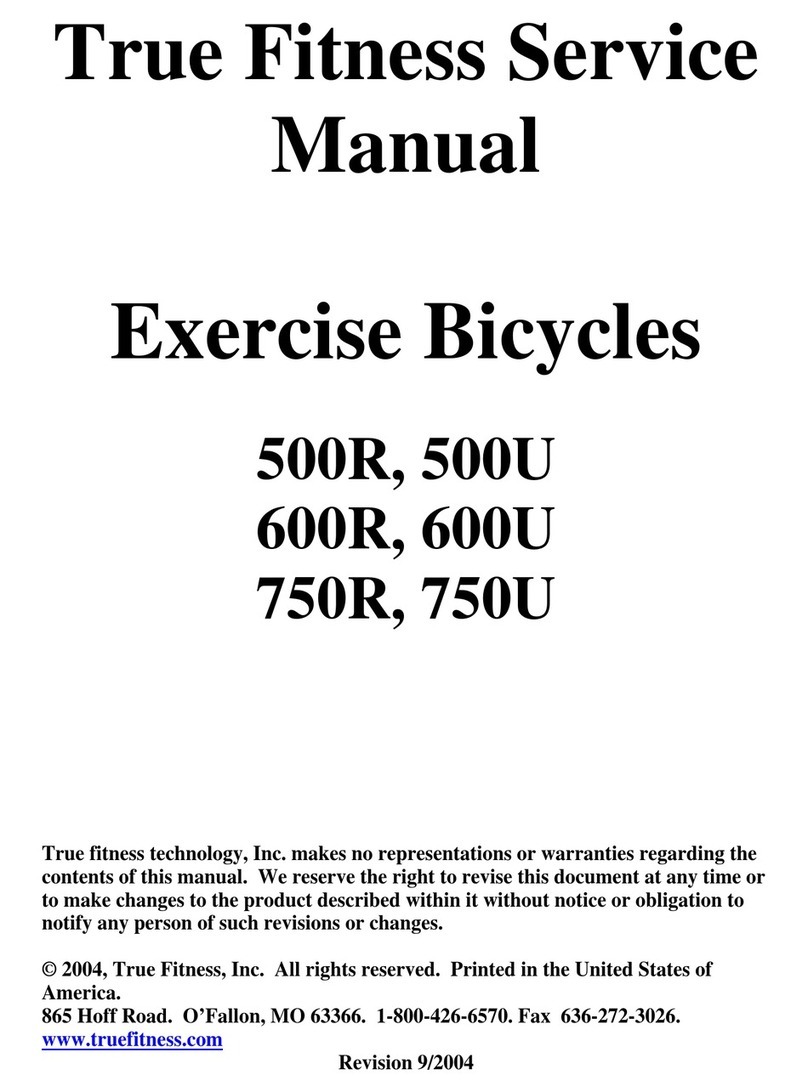
True Fitness
True Fitness 500U User manual

True Fitness
True Fitness ES900 User manual
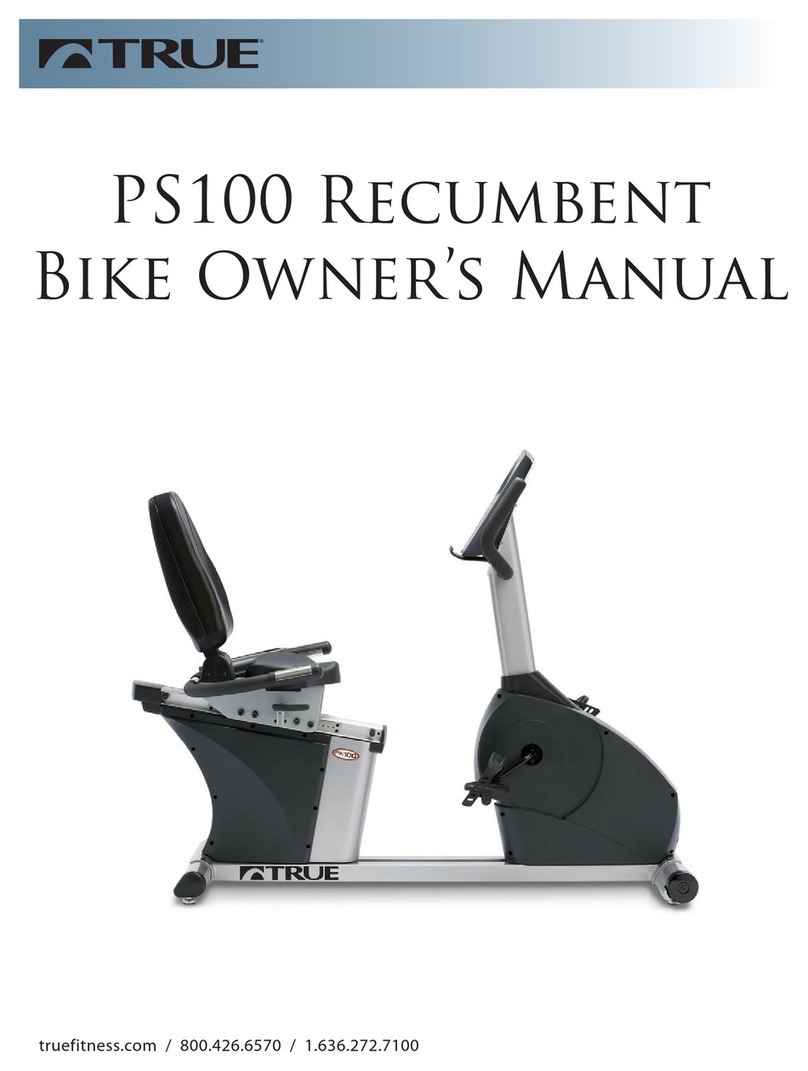
True Fitness
True Fitness PS100 User manual
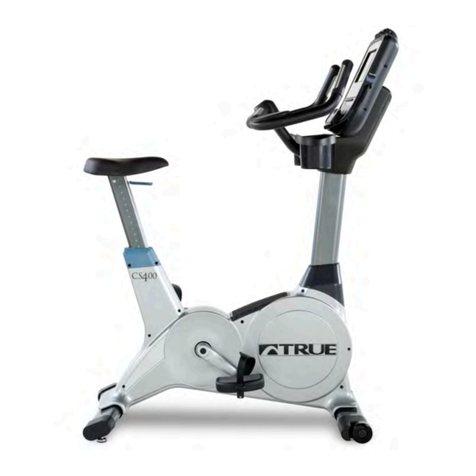
True Fitness
True Fitness CS400 User manual
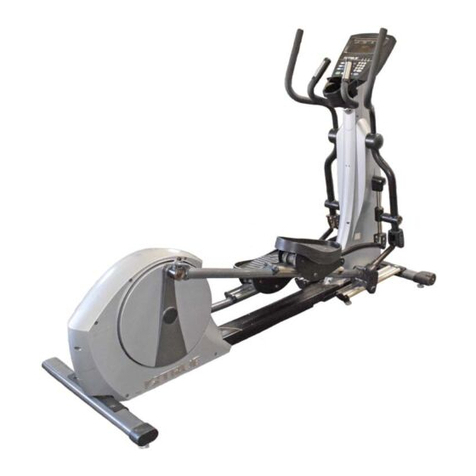
True Fitness
True Fitness Z7 Series User manual
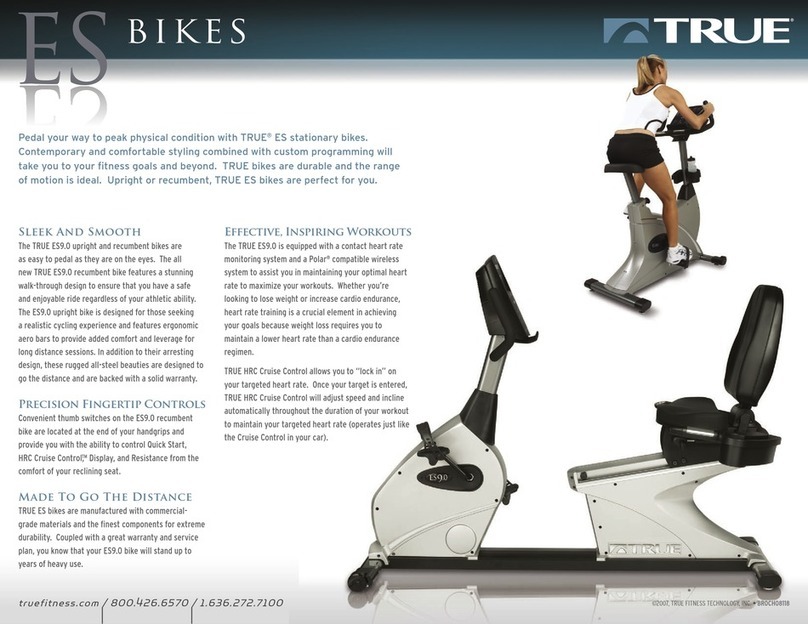
True Fitness
True Fitness ES User manual
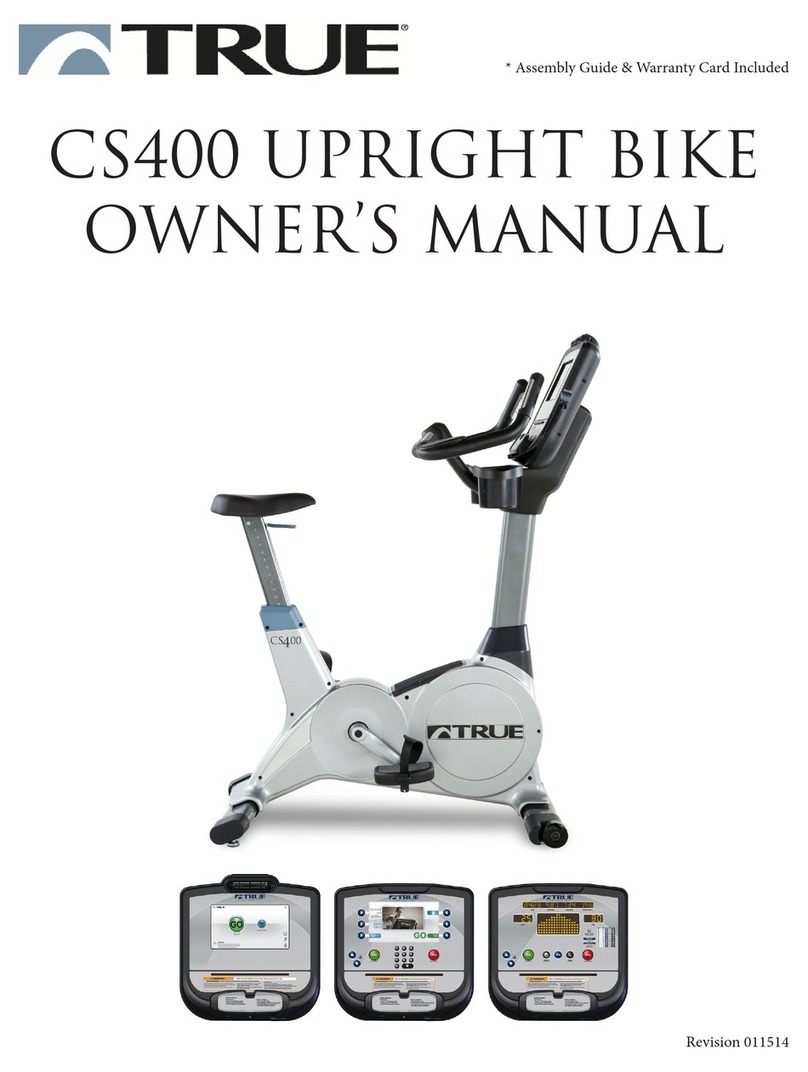
True Fitness
True Fitness CS400-9 User manual

True Fitness
True Fitness CS8 User manual
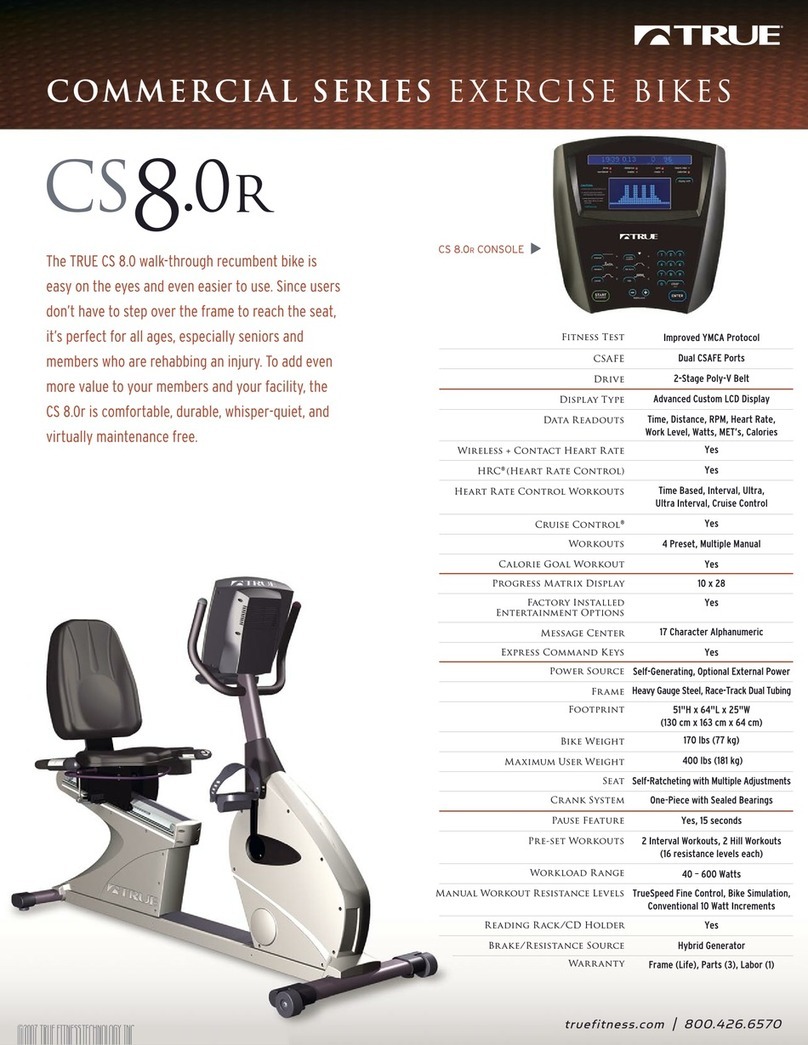
True Fitness
True Fitness Commercial Series Exercise Bikes CS8.0R User manual
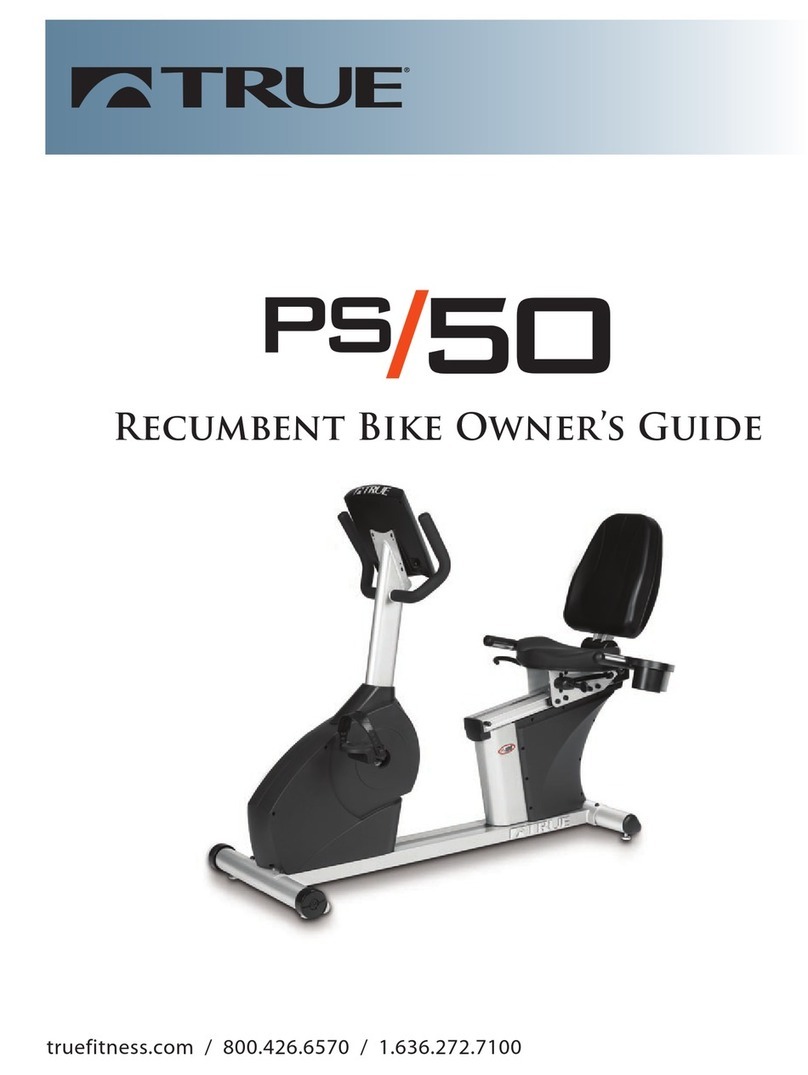
True Fitness
True Fitness PS/50 User manual
